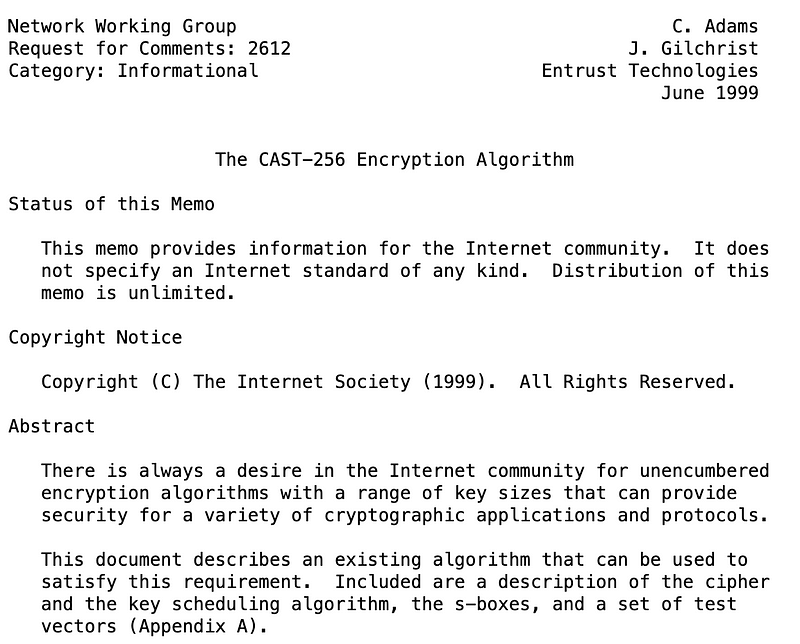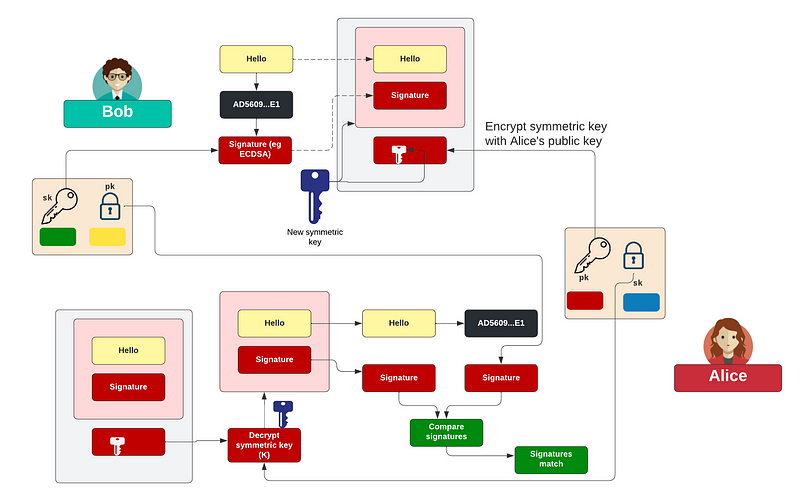CAST5

CAST5
CAST5 (or CAST-128) was created by Carlisle Adams and Stafford Tavares in 1996. It defines a symmetric key method that has a 64-bit block size, and key sizes from 40 bits up to 128 bits (in jumps of 8 bits). Typically any key less than 80 bits would be seen as being insecure. It uses a 12- or 16-round Feistel cipher. The 16-round version is used for keys for 80 bits and above. It has been standardized in RFC2612 [here]:

Phil Zimmerman could not believe there was no real security or trust built into email. So, in 1991, he created PGP (Pretty Good Privacy). With this, Bob creates a random symmetric key, which is used to encrypt a message. Bob then encrypts this symmetric key with Alice’s public key. When she receives the email she discovers the symmetric key with her private key and then decrypts the message:

But, Phil’s code then appeared outside the US, and in 1993 he was involved in a criminal investigation “munitions export without a license. While this was underway, his team released PGP 3, which improved the overall security of the software. With this, the team avoided RSA for the public key method, as it was protected under patent or royalty free. For signatures, they went for DSA and ElGamal, and for the symmetric key method, they chose CAST5 (which is royalty-free). A 256-bit version is also available as CAST-256.
PGP has advanced to the GNU Privacy Guard (GPG) and is based on OpenPGP. It ow supports the public key methods of RSA, ELG, DSA, ECDH, ECDSA, and EDDSA. Also symmetric key ciphers of IDEA, 3DES, CAST5, BLOWFISH, AES, AES192, AES256, TWOFISH, CAMELLIA128, CAMELLIA192, and CAMELLIA256, along with SHA1, RIPEMD160, SHA256, SHA384, SHA512, and SHA224. The compression methods supports are ZIP, ZLIB, and BZIP2:
https://asecuritysite.com/pgp/pypgp
The code is [here]:
import os
from cryptography.hazmat.primitives.ciphers import Cipher, algorithms, modes
from cryptography.hazmat.primitives import padding
import sys
message="Hello"
associated_data=b"Hello"
tag=b"0123456789ABCDEF"
keysize=5
iv = os.urandom(8)
mode=0
if (len(sys.argv)>1):
message=str(sys.argv[1])
if (len(sys.argv)>2):
mode=int(sys.argv[2])
if (len(sys.argv)>3):
keysize=int(sys.argv[3])
key = os.urandom(keysize)
padder = padding.PKCS7(64).padder()
unpadder = padding.PKCS7(64).unpadder()
cipher=None
if (mode==0):
cipher = Cipher(algorithms.CAST5(key), modes.CBC(iv))
if (mode==1):
cipher = Cipher(algorithms.CAST5(key), modes.OFB(iv))
if (mode==2):
cipher = Cipher(algorithms.CAST5(key), modes.CFB(iv))
if (mode==3):
cipher = Cipher(algorithms.CAST5(key), modes.ECB())
encryptor = cipher.encryptor()
str=padder.update(message.encode())+padder.finalize()
ciphertext = encryptor.update(str ) + encryptor.finalize()
# Now decrypt
decryptor = cipher.decryptor()
rtn=unpadder.update(decryptor.update(ciphertext) + decryptor.finalize())+unpadder.finalize()
print("Type:\t\t\t",cipher.algorithm.name)
print("Mode:\t\t\t",cipher.mode.name)
print("Message:\t\t",message)
print("Message with padding:\t",str)
print("\nKey:\t\t\t",key.hex())
if (mode!=3): print("IV:\t\t\t",iv.hex())
print("\nCipher:\t\t\t",ciphertext.hex())
print("Decrypt:\t\t",rtn.decode())
and a sample run [here]:
Type: CAST5
Mode: CBC
Message: Hello
Message with padding: b'Hello\x03\x03\x03'
Key: b1558e1272e5b6dc
IV: 4ce36ed28c8cd282
Cipher: cf8c21f475a58ac3
Decrypt: HelloConclusions
CAST5 is not used in most cases of symmetric key encryption, and which has been mainly replaced by AES and ChaCha20. But, with PGP3, it showed a vision of how to secure email. Unfortunately, we still typically use unsecured methods for email, but, at least, we have advanced the methods that PGP used. At its core, was the use of symmetric key encryption to encrypt a message, and public key encryption to protect the symmetric key.